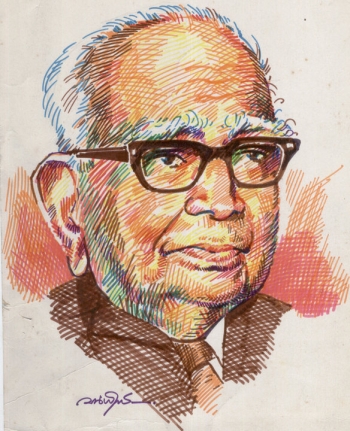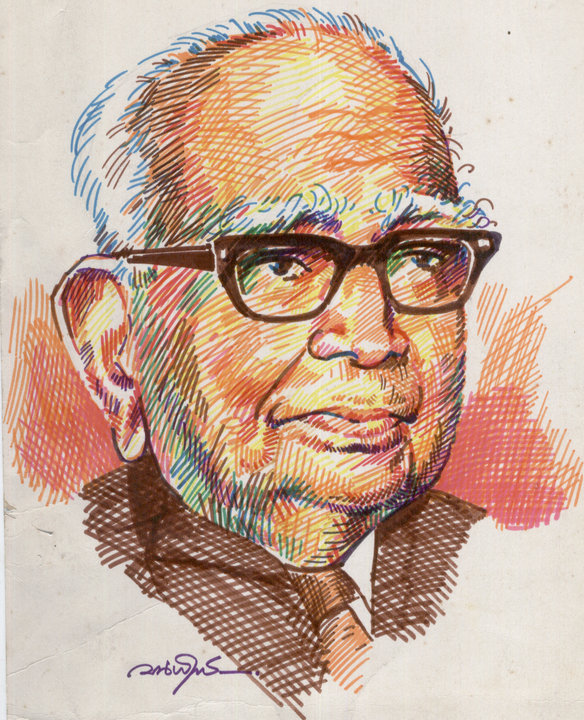
 A. J. Philip
A. J. Philip

The 121st birth anniversary of Cartoonist Shankar fell on July 31, 2023. The Kerala Lalit Kala Academy and the Kayamkulam Municipality, which turned 100, decided to celebrate the day with a three-day programme at Kayamkulam where Shankar was born. I was invited to give the main talk on Shankar for two days.
They chose me because I am one of the few people from Kayamkulam who met him in Delhi in 1974, soon after I started my career as a journalist. I had been a regular reader of Shankar's Weekly for less than 10 years from the mid-sixties to mid-seventies.
When he died in 1989, I wrote an editorial on him in the Hindustan Times. It is displayed as an exhibit at the Shankar Museum at Kayamkulam which all cartoon lovers should visit. It was my friend Cartoonist Sudheer who selected the cartoons displayed there from the thousands that appeared in various newspapers and Shankar’s Weekly.
Shankar’s house Illikkulam is less than a kilometre away from my house. In the nineties I did a feature on him in the Hindustan Times Sunday Supplement for which I visited his “ancestral” house of which only the gate (padippura) remained. I also interviewed his nephew, the only one in the family who inherited a bit of his drawing talent.
It is a different matter that the nephew, who is hard of hearing, runs a photo studio at the Second Milestone at Kayamkulam. Shankar’s wife Thankam was president of Kerala Club, set up in 1939, for a long period. I keep the chair warm for our president, centenarian Omchery N.N. Pillai, as vice-president of the club.
I accepted the invitation because I am a lover of cartoons. I started appreciating cartoons even before I started reading newspapers. In my childhood, I would wait for the Malayalam daily to read Mandrake the Magician, a syndicated comic strip, created by Lee Falk. I was also a fan of The Phantom, created by the same cartoonist.
Many years later, I had an occasion to meet Manthri (minister), a teacher-cum-cartoonist, who drew for Thaniniram (Real Colour), a scandalmonger, some considered a good example of yellow journalism. I felt bad when Manthri, a pseudonym the cartoonist used, was sacked from his job because he made bold to show his minister C.H. Mohammed Koya “in a poor light”.
Manthri had a harrowing time as the remuneration he received for his cartoons was peanuts. None from the media came forward to help him tide over his financial crisis. As I write from memory, I would like to be corrected if I am wrong on this.
I personally realised the importance of cartoons when I joined The Searchlight in Patna where my job included selecting photographs or cartoons, especially for the front page. We had a rotary press but it did not print photographs well. Blocks had to be prepared from photographs for printing purposes. Often, Indira Gandhi would look like Jawaharlal Nehru and vice versa when their photographs were printed. Often, the face would be indistinguishable from the smudge.
Our cartoonist was Ranga. Blocks made of line drawings were excellent for printing. The quality did not suffer even if the newsprint used was yellowish and made at Nepanagar in Madhya Pradesh. I would sometimes call Ranga to request him to send cartoons.
When it came to drawing Mahatma Gandhi, he could draw him faster than Artificial Intelligence would be able to do now. Come to think of it, it was the deficiencies in printing that forced editors to promote cartooning. I realised this when I read the biography of Joseph Pulitzer, an all-time great American journalist.
He realised that line drawings printed better than photographs. There were no cartoonists at that time. He found a footpath painter, who was willing to shift to line drawing, of course, for a decent fee.
On Pulitzer’s suggestion, he would draw and, thus, cartoons began to appear in his newspaper. Rival publications also took their cue from him and cartoons became an integral part of newspapers.
In India, Shankar is considered the father of cartooning. As the story goes, he drew a picture of his class teacher while he was sleeping in the classroom with his legs stretched on a table. When fellow children saw this, they could not contain their mirth, waking up the teacher.
The teacher took the picture to Shankar’s uncle to complain about his behaviour. His uncle was surprised by his nephew’s drawing talent. He was admitted to a school at Mavelikara where he got opportunities to watch students of the Raja Ravi Varma College Of Fine Arts sketching and painting.
Shankar began drawing for the Free Press Journal in Bombay when he went to the metropolis to study the law. He realised that his career was in cartooning, not law. And when the legendary editor Pothan Joseph, who holds a record in editing the maximum number of newspapers, including the Dawn of Pakistan, gave him a job in the Hindustan Times in New Delhi, he could not say no.
He served HT with distinction. Soon after he started his work, he was summoned by Viceroy Lord Willington. That day, he had done a cartoon depicting the Viceroy in a laughable condition. He thought his job was over as he stepped into the Viceroy’s House, now known as Rashtrapati Bhavan.
What he found was an amiable Viceroy who praised him for his cartooning skills. Mrs Willington had a complaint that her husband’s nose was not as long as he drew. Shankar had to explain to the couple that cartoonists tended to highlight some feature of a person’s face — like in the case of nose for Indira Gandhi, pout for Narasimha Rao and beard for Narendra Modi. “In that case, my nose will soon be more famous than me”, he reportedly commented.
Few people know that Shankar was “smoked out” of HT in the 16th year of his association with that paper. He started a paper with the support of industrialist Dalmia, who had six wives, one of whom fancied controlling the editorial policy of the paper. It was Shankar’s paper which became the forerunner of the Indian Express.
Thereafter he started his own Shankar’s Weekly. It was released by Prime Minister Jawaharlal Nehru, who had become Shankar’s close friend. Nehru would even drop in on Shankar to have a South Indian breakfast of steamed iddli, tangy and flavourful sambar and zesty, luscious coconut chutney.
Nehru concluded his speech with an appeal that came from the bottom of his heart, “Don’t spare me, Shankar”. What the Prime Minister meant was that he should not be afraid of criticising Nehru in his cartoons.
Shankar drew or published thousands of cartoons in which Nehru figured. The cartoons did not always show him in a good light. Towards the fag end of Nehru’s life, Shankar drew Nehru as taking part in a relay race. Those whom he depicted far behind Nehru were Lal Bahadur Shastri, Gulzarilal Nanda, Morarji Desai and Indira Gandhi, who all became prime ministers.
The cartoon also depicted V.K. Krishna Menon. Someone asked Shankar why he included Menon in the cartoon. “Am I crazy to believe that a Malayali would ever become Prime Minister?” He is yet to be proved wrong!
Today, technology allows newspapers to carry colour photographs. Cartoons have, therefore, ceased to be a must on the front page. For namesake, some newspapers publish pocket cartoons.
Cartoonists love lampooning the leaders. No editor would dare to lampoon the present crop of leaders, who will tell the Enforcement Directorate and the CBI: “Don’t spare the cartoonist and the editor”. Humour, especially through cartoons and stand-up comedy, has long been regarded as a powerful tool to challenge authority, break taboos, and shed light on societal issues.
However, throughout history, fascist rulers have consistently targeted and suppressed these forms of ex
Cartoons and satire have a unique ability to expose the flaws and excesses of those in power. Fascist rulers, who thrive on centralising authority and suppressing dissent, perceive such criticism as a threat to their legitimacy. By ridiculing their policies and actions, cartoons and comedians can expose the contradictions and failures of fascist regimes, undermining their authority and control.
One example is Benito Mussolini's Italy, where the fascist government strictly censored and controlled cartoonists and comedians, fearing their ability to challenge the regime's narrative. Similarly, Adolf Hitler's Nazi regime targeted political satirists, such as the famous cartoonist Hans Schweitzer, known as "Mjölnir," who used his cartoons to criticise the Nazi Party and its leaders.
Humour often thrives by pushing boundaries and challenging societal norms. Fascist rulers, with their rigid ideologies and desire for conformity, cannot tolerate the disruption caused by satire and comedy. They seek to maintain a controlled environment where dissenting voices are silenced, and taboos remain unchallenged.
During Francisco Franco's dictatorial rule in Spain, comedians and satirists faced severe restrictions. The regime targeted humorists like Enrique Tierno Galván, who used political satire to criticise Franco's regime.
Cartoons and humour have the power to expose and subvert propaganda, revealing their true nature to the public. By using irony, exaggeration, and wit, comedians and cartoonists can dismantle the carefully constructed narratives of fascist rulers, thereby challenging their control over public opinion.
In the Soviet Union under Joseph Stalin, political cartoons and satirical publications were strictly controlled. Artists who dared to criticise the regime through their work faced imprisonment or exile. One notable example is Mikhail Zoshchenko, a satirical writer whose works mocked the Soviet bureaucracy. His writings were considered subversive and were suppressed by the government.
Laughter has the remarkable ability to bring people together, creating a sense of camaraderie and resilience. Fascist rulers understand this power and fear the unifying effects of humour in mobilising resistance against their oppressive regimes. By suppressing laughter, they aim to weaken the spirit of opposition and maintain control over the populace.
Comedians like Kunal Kamra and Munawar Faruqui have been targeted. In such situations, it is no surprise that editors take the line of least resistance. And that is by employing illustrators and caricaturists, instead of cartoonists, especially political cartoonists like Abu Abraham, who drew President Fakhruddin Ali Ahmed in his bathtub asking whether there was any other ordinance to be signed. His cartoon exposed the cavalier manner in which the Emergency and Press censorship were imposed on the nation.
Once Cartoonist Kutti said, “per capita cartooning is so high in Kerala”. This is because Kerala has a tradition that can be traced to Kunchan Nambiar who lived in the 18th century. He made bold to lampoon those in power. There is a verse attributed to Nambiar.
As the story goes, a lamp post was being inaugurated by the King. The King naturally wanted all the poets to sing about his Deepa Sthambam. He gave them a lot of money for each poem.
Nambiar was reluctant and when he was forced to do it, he sang: “Deepa Sthambam mahascharyam,/Namukkum kittanam panam, (The lamp post is great and wonderful, I also should get the money)”. The King realised that Nambiar was making fun of him and he apologised to him for forcing him to compose the poem.
Today’s newspaper proprietors and editors are more than willing to please those in power. They are not like Rahul Gandhi who stood his ground and risked going to jail and losing his status as an MP, only to vindicate himself.
They know that it is a nuisance to publish cartoons. Small wonder that most young cartoonists have migrated to social media where, too, they are not safe as the government has the means to monitor their work and take them to task. As a result, we are witnessing an end of political and social cartooning that can flourish only in a liberal state. That is the sad thought I had as I returned from Kayamkulam.